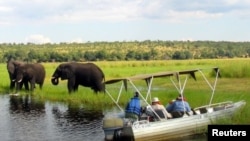Recognizing that some of the world’s iconic animals are dangerously close to extinction, the United States Congress established the Multinational Species Conservation Funds. The first of these, the African Elephant Conservation Fund, was established in 1989. The aim is not only to preserve these animals, but to maintain them in their natural habitats. The Funds are administered by the U.S. Fish and Wildlife Service through its Wildlife Without Borders programs.
Through these programs, the Fish and Wildlife Service awards grants for projects aimed at conserving endangered species found outside U.S. borders. This year, the Service is awarding $15.5 million in international conservation grants to partners in 60 countries around the globe. That initial $15 million sum will also raise another $22 million in matching funds through the Fish and Wildlife Service’s partners, which include non-profit organizations, government agencies, universities, and community groups.
Of that original grant, $12.5 million will go toward conserving critically endangered species such as tigers, elephants, rhinoceri, apes, marine turtles and amphibians. The remaining $2.9 million will facilitate capacity building and technical assistance in Africa, Latin America and the Caribbean, Mexico, Russia and East Asia.
Such funding is crucial to front-line conservation efforts. It will facilitate anti-poaching activities, law enforcement, community outreach, habitat restoration, disease research, and mitigation of human-wildlife conflict.
For example, in South Africa, CapeNature will use some of its grant money to control invasive pine trees, thus helping to reduce the risk of catastrophic fires in the Rough Moss Frog habitat. In Indonesia, the money will help the Wildlife Conservation Society protect Sumatran orangutans by providing it with the means to combat the illegal trade in wildlife. And in Colombia, Fundación Proyecto Titi will aid rural communities through sustainable development projects that reduce deforestation in the cotton-top Tamarin’s habitat.
“These grants provide crucial assistance in the effort to prevent extinction by reducing threats to species survival and increasing the capacity of communities to value, conserve, and manage their wildlife,” said Fish and Wildlife Director Dan Ashe. “The Service’s Wildlife Without Borders program funding is vital to saving some of our fastest disappearing and most treasured species, empowering people to help conserve key habitats, and form innovative conservation partnerships worldwide.”
Protecting Endangered Wildlife

Recognizing that some of the world’s iconic animals are dangerously close to extinction, the United States Congress established the Multinational Species Conservation Funds.
















